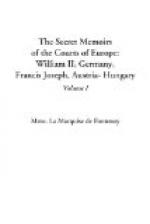On the eve of the day on which the hunt is to begin, and when the party are assembled in the smoking and card-rooms of the jagdschloss, after dinner, the great oak table in the dining-room is cleared and ornamented with several lines of chalk; thereupon, the deputy grand huntsman, Baron Heintze Weissenrode, after receiving the emperor’s final instructions, selects a dozen members of the party, and conducts them to the dining-room, where they take their places around the table, each armed with a wooden spoon of a different size from those of his neighbors.
At a given signal the huntsman in charge of the imperial pack of boar-hounds, who has been stationed at the entrance leading into the dining-room, sounds the “view-halloo!” on his horn, and immediately every one of the wooden spoons is rubbed up and down the oaken table in a manner that produces a sound similar to that of the noise made by a pack in full pursuit. The person about to be initiated is then seized and blindfolded, after which the doors are thrown open, and he is carried into the dining-room, and laid upon the table athwart the chalk lines. The emperor immediately draws his short hunting-knife, and after making several mystic passes with it in the air, strikes the prostrate body of the neophyte a smart blow with the flat of the broad blade. The huntsman toots forth the signal of “dead! dead!” which is used to call the pack off the quarry, and the new-fledged “weide-man” is permitted to struggle off the table and onto the ground.
I may add that the emperor’s blow with the hunting-knife is not the only one which the neophyte receives while stretched on the table on his face, nor does it constitute the sum total of the initiation, but only the conclusion thereof. Indeed, there is sometimes a good deal of rough horse-play on these occasions, in which the emperor, who delights therein, takes a prominent part.
The boar hunt on the following day partakes of the nature of the chamois drives already described, the only difference being that the beaters are assisted in their work by a carefully trained pack of boar-hounds, which are accustomed to obey the horn signals of the huntsman in charge, and are of much service in driving the quarry from its lair in the dense brush and underwood.
Another difference is that the shooting parties, instead of firing in the direction of the drivers, are under the strictest orders only to fire away from them; that is to say, the hunters are practically forced to wait until the wild boar rushes past before their rifles may be levelled. Of course, it sometimes happens that the boar, instead of charging past, charges directly at some member of the party in the fiercest and most dangerous manner, and it is in order to be prepared for an assault of this kind, that each of them is provided with a kind of pike, or lance, which goes by the euphonious name of “sowpen.”
The costume worn on these occasions is an exceptionally hideous uniform, specially invented and devised by the present emperor. It consists of a double-breasted frock coat of grey cloth, with grass-green lapels and collar, green striped pantaloons, high boots, and a grey Tyrolese hat, with a wide green band. In the emperor’s case it is further adorned by the ribbon and badge of a Hohenzollern family order known as that of the “White Hart.”




